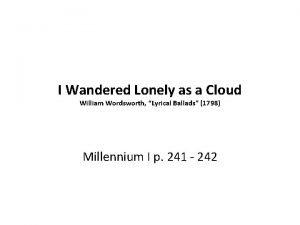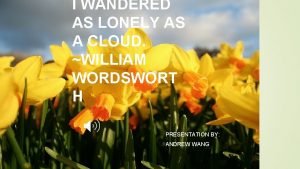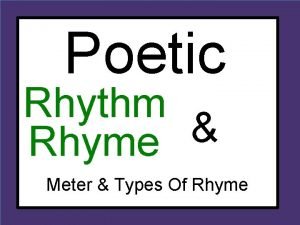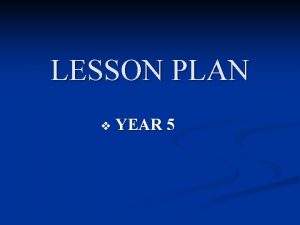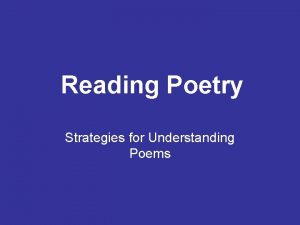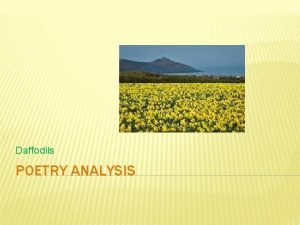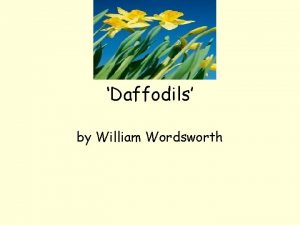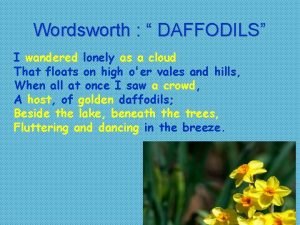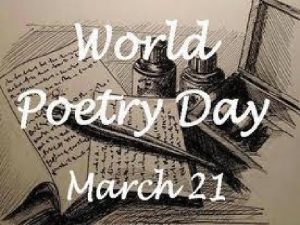I Wandered Lonely as a Cloud William Wordsworth







- Slides: 7

I Wandered Lonely as a Cloud William Wordsworth, “Lyrical Ballads” (1798) Millennium I p. 241 - 242

1. • In this poem often known as “Daffodils” the poet is wondering alone through the countryside. Which word/s from the definition of “Daffodil” do you expect to find in the poem? Dictionary definition of “daffodil”: a yellow bell-shaped flower with a long stem which is commonly seen in spring. I would expect to find words like “yellow”, flower”, “spring”, “bloom”, “smell” etc. I wandered lonely as a cloud That floats on high o'er vales and hills, When all at once I saw a crowd, A host, of golden daffodils; 5 Beside the lake, beneath the trees, Fluttering and dancing in the breeze. a Continuous as the stars that shine And twinkle on the milky way, They stretched in never-ending line 10 Along the margin of a bay: Ten thousand saw I at a glance, Tossing their heads in sprightly dance. a b c c The waves beside them danced; but they Out-did the sparkling waves in glee: 15 A poet could not but be gay, In such a jocund company: I gazed--and gazed--but little thought What wealth the show to me had brought: a b c c For oft, when on my couch I lie 20 In vacant or in pensive mood, They flash upon that inward eye Which is the bliss of solitude; And then my heart with pleasure fills, And dances with the daffodils. a b c c b a b c c movement sight light prepositions of place RHYME SCHEME ababcc

1. Highlight the verbs in the poem suggesting the following ideas, then write down some examples. movement 2. sight saw_____________________________ light shine___________________________ Focus on the speaker’s action: what is he doing? a. Tick the right verb among the following: – walking running strolling roaming b. Now build a sentence of your own around each of the following verbs: – to walk – I missed the bus this morning so I walked to school. – to run – 3. wondered________________________ I ran all the way home to inform my parents that I had passed the exam. – to stroll – At six o clock in the morning there were already some people strolling along the beach. – to roam – After the pubs close, gangs of youths roam the city streets. Look at the prepositions Wordsworth uses in the text. Highlight in green the one related to places.

LANGUAGE THROUGH LITERATURE 4. Now complete the grids below. Start with the prepositions of place you have found in the text and then add some more. beneath, underneath, on, over, upon, below, down. above, up. beside, along, in 5. Highlight the poetic devices used in the poem and write down some examples. simile “lonely as a cloud” (l. 1); “Continuous as the stars” (l. 7). In the first stanza the poet compares himself to “a cloud”, while in the second he compares the line of daffodils to “the stars that shine / And twinkle on the milky way”. Notice how earth and heaven are united in the beauty of the daffodils. metaphor “inward eye” (l. 21) anaphora “And / And” (ll. 23 -24) run-on line “cloud / That floats. . . ” (ll. 1 -2); “shine / And twinkle” (ll. 7 -8); “line /Along the margin. . . ” (ll. 9 -10); “but they / Out-did” (ll. 13 -14); “little thought / What wealth” (ll. 17 -18); “I lie / in vacant. . . ” (ll. 19 -20); “inward eye / Which is the bliss” (ll. 21 -22).

GUIDED ANALYSIS 1. Consider stanza 1 a. The first line compares the poet to a cloud. What does the image of the cloud suggest to you? More than one choice is possible. a. b. c. d. e. freedom loneliness beauty dreams laziness The image of the single cloud in the sky can suggest ideas of freedom and loneliness, but also the habit of dreaming, more precisely of daydreaming (= dreaming with open eyes about something beautiful/pleasant). b. In lines 3 -4 the terms used to define the groups of daffodils are. . . c. “crowd” and “host” 2. Consider stanza 2 a. In lines 7 -8 the poet compares the line of daffodils to “the stars. . . on the milky way” b. In lines 12 he says that they throw up their “heads” in a “ sprightly dance”

c. By using these words the poet wants to: a. b. c. emphasize the daffodils anthropomorphize the daffodils spiritualize the daffodils 3. Consider stanzas 3 and 4. a. What is the prevailing feeling of the poem? Which words express it ? The prevailing feeling is a spontaneous overflow of joy and happiness, as expressed by the words: “they / Out-did the sparkling waves in glee” (ll. 1314), ; “A poet could not but be gay / in a such a jocund company “ (ll. 15 -16); “ the bliss of solitude” (l. 22); “my heart with pleasure fills / And dances with the daffodils” (ll. 23 -24). b. Does the poet get pleasure from seeing the daffodils or from remembering the scene he saw? Find evidence in the text? The pleasure is more in remembering the scene he saw, since what really matters is the internal eye which creates the poetic vision using the material received from the senses. This is clearly shown in lines 17 -18 where the poet declares that he was not really conscious of the beauty of the scene at the time when he saw the daffodils. True awareness and pleasure come only when the poet is in “vacant or in pensive mood” (l. 20). The act of seeing is a prerequisite and a condition of poetic vision but never a substitute for it.

c. – 4. Loneliness is the condition of the poet. Is it positive or negative? What does the poet gain by it? It is positive because the poet gains happiness through a sense of deep communion with nature. Look back on the whole poem and underline all the verbs. a. b. – In the first three stanzas the tense used is the. . . past tense while in the last stanza we have the. . . present tense, Why is the change of tense important to the comprehension of the meaning of the poem? The first three stanzas refer to a past situation, while the last one is a permanent condition of the poet in meditation. The change of tense underlines the gap between the past experience and its remembrance in the poet’s present which gives him a moment of ecstatic vision.
